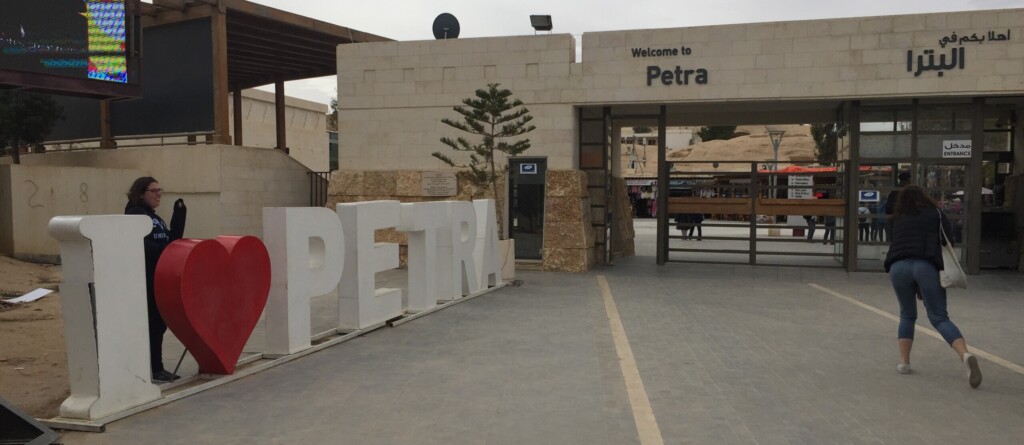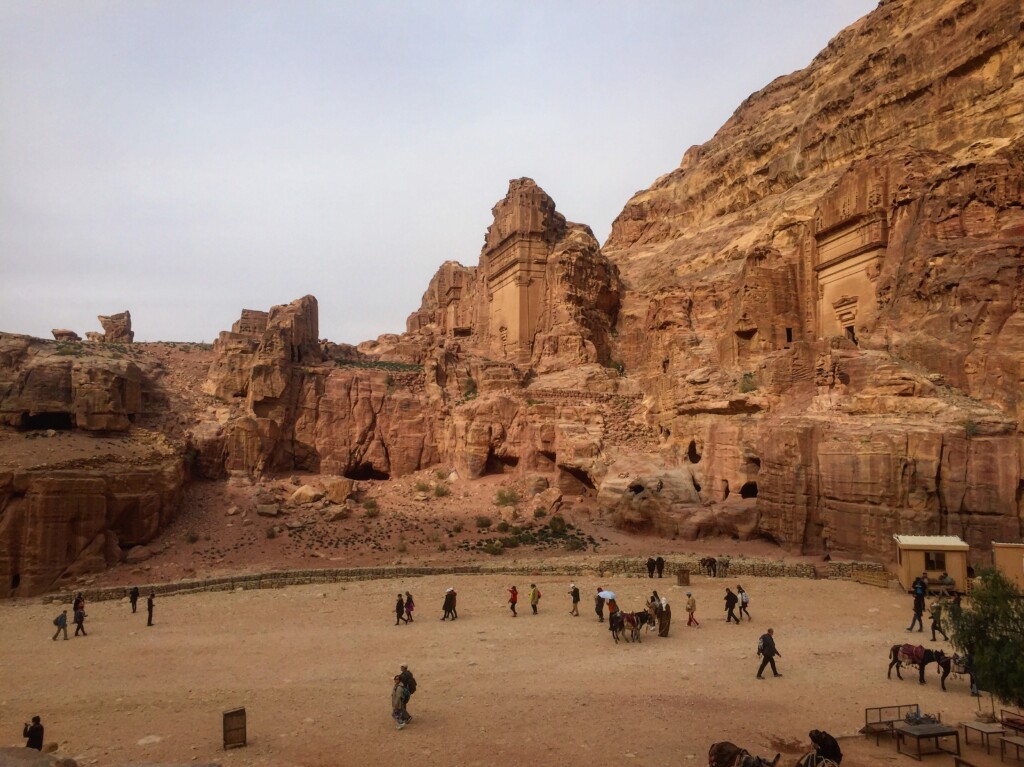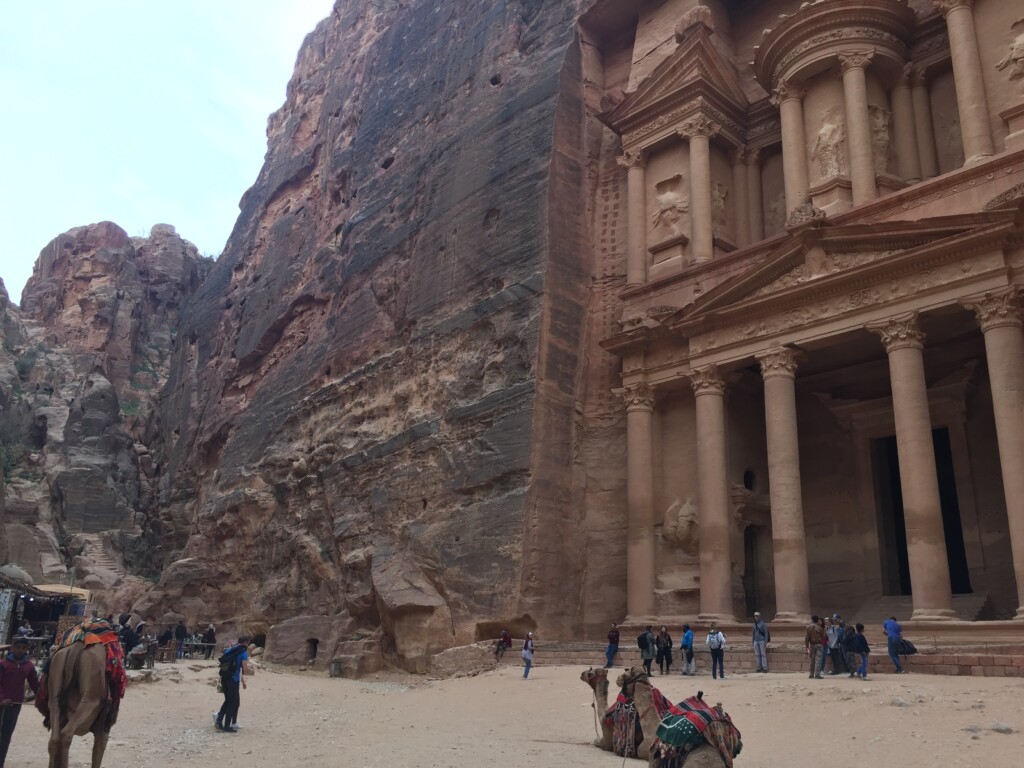
When you first see the “I Heart Petra” sign, know that it’s not just a catchy slogan—it’s a sentiment you’re likely to share by the end of your visit. Petra is a place that captivates, mesmerizes, and leaves you in awe. But it’s also a place where you need to prepare yourself for both the beauty and the challenges that come with it. Let’s dive into what makes Petra a must-see destination, and what you need to be aware of before you go. Also, nearby is the Wadi Rum desert. So you would be smart to include a stop at both of these amazing destinations. There are tours that run to both spots out of Amman or Israel, but we digress. Back to the main attraction!
A City Carved into History
Petra isn’t just a tourist site; it’s a marvel of ancient engineering and artistry. Imagine an entire city carved into the side of a mountain, its grand facades and intricate tombs emerging from the pink sandstone cliffs like something out of a dream. The Nabateans, an ancient Arab people, began carving Petra out of the rock over 2,000 years ago, creating a thriving metropolis that became the center of their kingdom. They didn’t just build a city—they etched their legacy into the earth, creating structures that have stood the test of time.
One of Petra’s most astonishing features is its scale. This is not just a collection of ruins; it’s an entire city complete with homes, temples, and an amphitheater that could seat 8,000 people. Walking through Petra, you can’t help but marvel at the craftsmanship and vision it took to create such a place. It’s no wonder that Petra was named one of the New Seven Wonders of the World and is Jordan’s most visited tourist attraction.

The Iconic Treasury
Perhaps the most famous of Petra’s many treasures is the Treasury building, or Al-Khazneh. You’ve probably seen it in countless photos and movies—most notably in Indiana Jones and the Last Crusade. But nothing compares to seeing it in person. The Treasury is a towering structure, standing at 130 feet tall, carved directly into the rock face. It’s a jaw-dropping sight, and as you round the final bend in the Siq, the narrow canyon that leads into Petra, your first glimpse of the Treasury will be one you’ll never forget.
But here’s an interesting tidbit: despite its name, the Treasury was never actually used to store treasure. It was, in fact, a tomb—one of many that dot the landscape of Petra. Its elaborate facade, with its Corinthian columns and intricate carvings, speaks to the importance of those who were laid to rest here. The Nabateans believed in an afterlife and went to great lengths to ensure their dead were honored with grand monuments. The Treasury is the most famous of these, but it’s just one of many such structures in Petra.

Walking Through the Siq: A Journey into the Past
Your journey to Petra begins at the Siq, the ancient main road leading to the city. The Siq is a narrow, winding canyon flanked by towering walls of sandstone, some reaching up to 80 feet high. Walking through the Siq is like stepping back in time. The canyon’s smooth walls, shaped by water and wind over millennia, are a natural masterpiece in their own right. As you walk, you’ll notice the remnants of the original road, built by the Nabateans in the first century BC. It’s a place where history and nature intertwine, creating a path that is as much a part of Petra’s story as the city itself.
The nearly mile-long trek through the Siq is one of the highlights of visiting Petra. It’s a place where you can truly appreciate the natural beauty of the landscape, and for the most part, you’ll be left alone to enjoy it. This is your chance to soak in the sights, take a ride on a horse-drawn carriage, and let the anticipation build as you get closer to the city. The Siq is your gateway to Petra, and it’s an experience you’ll treasure.

The Ugly Truth About Petra
While Petra is undeniably beautiful, it’s important to be aware of some of the challenges you might face during your visit. Unfortunately, one of the less pleasant aspects of visiting Petra is the persistent harassment from some of the locals. It’s not uncommon to be hassled by children and adults alike, who may aggressively demand money in exchange for various “services,” like allowing you to climb certain rocks or guiding you to specific spots.
This kind of behavior can be intimidating and frustrating, especially if you’re not expecting it. Many visitors have reported feeling harassed, and it’s something that can really put a damper on an otherwise incredible experience. It’s important to be firm and assertive, and don’t feel pressured to give in to demands. Remember, you’re not obligated to pay anyone for access to public areas within Petra.
One of the best ways to avoid this is to visit Petra early in the morning or later in the afternoon when the crowds are thinner, and the locals are less aggressive. It’s also helpful to read reviews and get advice from other travelers who have been to Petra. Being prepared can make a big difference in how you experience the site.

Exploring Petra: Beyond the Treasury
While the Treasury gets most of the attention, Petra is much more than just one building. The ancient city stretches for nearly 40 miles, with countless tombs, temples, and other structures to explore. Some of the highlights include the Monastery, another massive rock-carved structure that rivals the Treasury in grandeur, and the Royal Tombs, a series of impressive burial sites located on the cliffs overlooking the city.
Then there’s the Roman Theater, a testament to Petra’s role as a cultural crossroads. This amphitheater, carved into the rock, once seated more than 8,000 people and hosted performances and gatherings. Walking through Petra, you’ll also come across numerous smaller tombs, religious buildings, and even remnants of ancient markets. Every corner of Petra has a story to tell, and exploring the city is like piecing together a vast, intricate puzzle.

One of the most rewarding aspects of visiting Petra is the sense of discovery. With every step, you uncover a new piece of history, a new marvel of engineering, or a breathtaking view. Whether you’re climbing to a high vantage point for a panoramic view of the city, or wandering through the quiet canyons and caves, Petra offers endless opportunities for exploration and wonder.

A Final Word of Advice
Petra is a place of extraordinary beauty and historical significance, but it’s also a place where you need to be prepared for the realities of tourism in a developing country. The harassment from locals can be a major downside, but it doesn’t have to ruin your experience. By being aware of what to expect and knowing how to handle it. You can ensure that your visit to Petra is as memorable and enjoyable as possible.
In the end, Petra is worth every moment of hassle. It’s a place that will leave you in awe, a place where history comes alive. And where the wonders of the ancient world are still within reach. Whether you’re a history buff, a movie fan, or just someone looking for a once-in-a-lifetime adventure, Petra is a destination you won’t want to miss.
So, pack your bags, brush up on your negotiation skills, and get ready to fall in love with Petra. It’s a journey you’ll never forget. But it’s an experience you’ll carry with you long after you’ve left its ancient walls behind.

